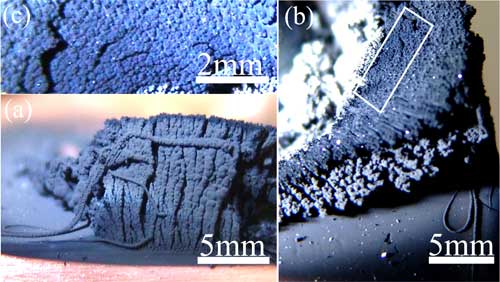| Posted: Nov 06, 2006 | |
Rare-earth nanocapsules as a new type of nanomaterial for cryogenic magnetic refrigerators |
|
| (Nanowerk Spotlight) The interest in research on magnetic nanocapsules has increased considerably since it was found that their intermediate states between bulk and atomic materials may present different magnetic behaviors from their correspondent bulk counterparts. This difference offers an opportunity for researchers to develop many important technical applications such as magnetic refrigerators, magnetic recording, or magnetic fluids. | |
| As the principal contributor of the novel properties, various magnetic cores of nanocapsules, including rare earths and their carbides, have been researched extensively over the past two decades. In addition, cores of magnetic rare-earth intermetallic compounds are becoming a major research focus. | |
| However, there have been considerable difficulties in preventing oxidation of the particles of rare-earth elements and compounds. Researchers in PR China have now succeeded in synthesizing a new type of intermetallic nanocapsule that can be applied in cyrogenic magnetic refrigerator devices. | |
| It was found previously that nanoparticles of ferromagnetic intermetallic compounds may exhibit an effective magnetic moment that is greater than the magnetic moment of the constituent atoms, so the magnetic entropy of the nanoparticles may have a maximum enhancement of the magnetocaloric effect (MCE). This MCE is a magneto-thermodynamic phenomenon in which a reversible change in temperature of a suitable material is caused by exposing the material to a changing magnetic field. | |
| It is a common fact that it is extremely difficult to synthesize the nanoparticles/nanocapsules with rare-earth elements or compounds because of the chemical activity of the rare earths. Therefore, it is necessary to explore a new type of nanoparticle to acquire larger entropy change and to prevent the magnetic nanoparticles from being oxidized. | |
| Such a new type of nanoparticle, in the form of a superparamagnetic GdAl2 nanocapsule, was synthesized by the Chinese researchers. With high atomic moments, low crystalline anisotropy and shell protection it has more advantages than other nanocomposites for applications in cryogenic magnetic refrigerator devices. | |
| Dr. Song Ma, from the Magnetism and Magnetic Materials Research Division at the Shenyang National Laboratory for Materials Science in Shenyang/PR China, explains the new findings to Nanowerk: "In preparations of single rare-earth element nanoparticles encapsulated by graphite, the rare-earth carbides always coexist with the rare-earth nanocapsules. This phenomenon led us to utilize an arc-discharge technique with modified strategies, involving changing the hydrogen pressure, introducing a gadolinium–aluminum alloy ingot as the anode, and adjusting the proportions of elements in the anode according to their evaporation pressures, That way we synthesized a new type of magnetic nanocapsule, with the intermetallic compound GdAl2 as the core and amorphous Al2O3 as the shell. The Al atoms easily condensed on the surface of the nanoparticles to prevent them from oxidization." | |
| Ma is first author of a recent paper, titled "Synthesis of a new type of GdAl2 nanocapsule with a large cryogenic magnetocaloric effect and novel coral-like aggregates self-assembled by nanocapsules", that was published in the October 13, 2006 online edition of Nanotechnology. | |
| This work provides a new method to overcome the difficulty due to oxidization of rare-earth atoms during the preparation of nanoparticles of rare-earth elements or compounds and it opens up a new way of synthesizing more magnetic nanocapsules of rare earth compounds. | |
| A second result of the work was the observation that, at the same time as the nanocapsules were fabricated by the arc-discharge process, regularly aligned three-dimensional, coral-like macro-aggregates were self-assembled by the nanocapsules without any template and catalyst. This is unusual as the arc-discharge method has rarely been used to synthesize self-assembled macro-aggregates from nanoparticles. | |
| The macro-morphology of the aggregates is shown in the images below, in which the large-scale coral-like aggregates array vertically, orderly and closely in front of the target that locates in the pit of copper crucible (1a). The farther from the target, the higher the aggregates grow (1b); the longest aggregate is about 9 mm. Every tip of the aggregates can be clearly observed in (1c), indicating that every aggregate grew separately in the arc-discharge process. Noteworthy is that one single aggregate on the outside of the vertical arrays grows transversely down to the black layer on the copper crucible and its diameter decreases. | |
 |
The macro-morphology of the aggregates of (a) the front view, (b) the top view and (c) the local top view of the aggregates shown in marking frame in figure 1(b). (Source: Song Ma) |
| "With this new work it now seems possible that the arc-discharge technique can be developed into a new way of synthesizing macro-aggregates without templates or catalysts" says Ma. | |
| Based on the team's recent findings, Ma sees two directions for their future work: The research of additional new types of intermetallic compounds and the study of their magnetocaloric effect; the exploitation and study of three-dimension macro-aggregates and their formation mechanisms, especially with regard to potential applications in nanoelectronic or magneto-optical devices. | |
 By
Michael
Berger
– Michael is author of three books by the Royal Society of Chemistry:
Nano-Society: Pushing the Boundaries of Technology,
Nanotechnology: The Future is Tiny, and
Nanoengineering: The Skills and Tools Making Technology Invisible
Copyright ©
Nanowerk LLC
By
Michael
Berger
– Michael is author of three books by the Royal Society of Chemistry:
Nano-Society: Pushing the Boundaries of Technology,
Nanotechnology: The Future is Tiny, and
Nanoengineering: The Skills and Tools Making Technology Invisible
Copyright ©
Nanowerk LLC
|
Become a Spotlight guest author! Join our large and growing group of guest contributors. Have you just published a scientific paper or have other exciting developments to share with the nanotechnology community? Here is how to publish on nanowerk.com.
